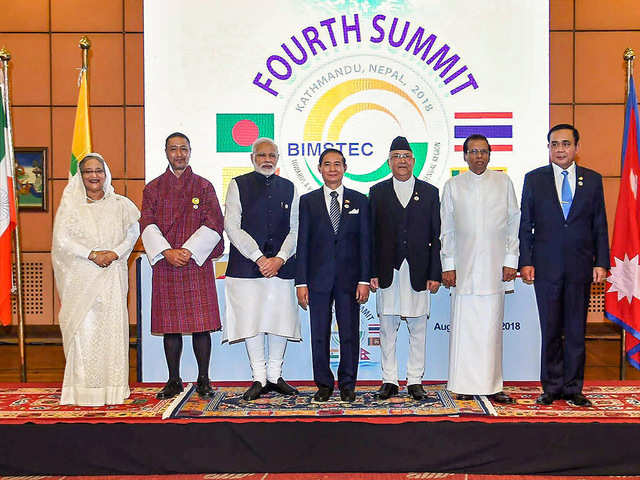Afsan Chowdhury, June 12, 2019

economictimes.indiatimes.com
In its new scheme of things, India has chosen to push SAARC aside and replace it with BIMSTEC, a moribund regional body. By refusing to invite Pakistan to his inaugural function, Prime Minister Narendra Modi has sent a signal to Pakistan and his Indian audience that he is anti-Pakistani first and foremost, and, by extension, cares little for SAARC in which Pakistan is a key member.
But unless India makes efforts to energize the Ocean Rim body BIMSTEC, regional units will look elsewhere for financial succor and developmental support.
Read Also: Court ticks off Bangladesh Central Bank for being blatantly pro-rich
Modi’s policy on Pakistan is beginning to resemble the Cold War with opposition to all things Pakistani. Interestingly, Modi is not applying his own Sino-Indian relationship model to Indo-Pakistan relations. As per the Sino-India model, political hostility can co-exist with business and trade expansion.
India’s trade relations with China has not withered even as the two countries face-offed at Doklam in 2017. Both parties follow the new rules of the game. But India does not apply this to the region. By cold shouldering Pakistan, India is cold shouldering SAARC. And now SAARC has been replaced by BIMSTEC as India’s focus.
However, the problem is that BIMSTEC is not exactly an active body which can fill the vacuum left by SAARC’s exit.
Sleeping BIMSTEC
BIMSTEC was floated in 1997 largely to counter SAARC or exclude Pakistan from regional equations. The Bay of Bengal hugging countries are part of this grouping which also includes Thailand and Myanmar.
Interestingly, Nepal and Bhutan were added to BIMSTEC’s membership though both are landlocked. It was felt that just because they are not ocean-rimmed countries, they cannot be denied the benefits of cooperation in building up an ocean economy or a Blue Economy.
SAARC has declined, but BIMSTEC has not grown. However, this has suited India fine because its main purpose has been to isolate Pakistan. The problem is that BIMSTEC doesn’t serve regional member countries which are keen to develop trade opportunities between themselves. Although BIMSTEC’s HQ is in Dhaka, few know much about it and its activities. Its funds are inadequate.
From BIMSTEC to BRI?
If BIMSTEC is inactive, its member-countries are bound to look elsewhere for support and cooperation. And this is where China’s Belt and Road Initiative (BRI) comes in. BRI has both an enormous technical capacity and a deep pocket, though it has generated some anxiety about its debt creating potential.
Prof. Rehman Sobhan, Bangladesh’s eminence grise in the field of economics, writing in the daily Dhaka Tribune has argued that the BRI is emerging as the platform for equitable growth in Asia and the developing world.
“As we moved into the 21st century, a new more sustainable set of opportunities for the Third World to construct a more just and balanced global economic order has presented itself. The onward thrust of globalization has led to transformative changes in global comparative advantage.”
“In terms of global competitiveness, China has emerged as the world’s largest economy in PPP terms with India in third place. Between 1990 and 2017, Asia’s share of global GDP increased from 23.9% to 35.8% while China’s share of GDP grew from 1.6% to 15.2%. In the area of global trade, Asia’s share increased from 22.7% in 1990 to 37.6% in 2017. China’s share of global trade in this same period increased from 1.6% to 11.5%.”
Read Also: The South Asia Triangle: Life after SAARC’s end
“China therefore decided to autonomously move further through The Belt and Road Initiative (BRI) program by drawing upon its enormous financing capacity. Chinese commercial banks such as the Bank of China and the CITIC had already engaged themselves in funding large investment projects across the world. In 2014, for example, Exim Bank of China disbursed $80bn in project financing, more than the total disbursement of the seven largest development finance institutions. China has now set up a more dedicated BRI funding facility, the Silk Road fund.”
The big difference is China’s ability to spend massively in contrast to India, whose pocket is shallow.
Deep pocket matches hunger for funds
India’s objective is to deal with its smaller neighbors from a dominant position without foregoing the advantages it has with China. China wants both India and its neighbors and vice versa. India assumes that its neighbors (ex-SAARC) will not fall for BRI. But the fact is that they already have fallen for the BRI. For them, the BRI is virtually the only source of substantial and quick funding.
China’s deep pocket and the deep hunger of the smaller countries for finance, dovetail. This is not going to help India redesign its neighborhood policy. Unless benefits from ties with India are proven, and South Asian regional bodies are allowed to function, the BRI or any of its offspring will be a credible alternative. The BRI has already made SAARC irrelevant. And BIMSTEC may meet the same fate.
The longer BIMSTEC takes to become active, the greater will be China’s ability to overwhelm all other regional bodies.
